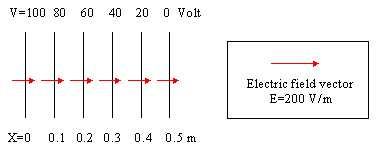Suppose in two parallel plates, which are 0.5 m apart, the electric potential decreases uniformly from 100 V to 0 V. The variation of potential with distance x is shown in the next figure.

The potential function is represented by the following equation:
|
V(x) = 100 - 200x | (9) |
The field is calculated using Equation (7),
|
| (9) |
Because our equation for V is in only one direction, the gradient of V is simply equal to the first derivative of V.
Equipotential surfaces are imaginary surfaces defined by the equation V(x,y,z) = C where C is a constant. If the equipotential surfaces are projected on the xy-plane (z=0), the two-dimensional display V(x,y)=C become equipotential lines. In this module, equipotential lines (or just equipotentials) are shown as black lines.
Field lines are used to indicate the direction and magnitude of the electric field at a point. In this module, we use red arrows on top of plots of equipotential lines.
The electric potential and the field given in Equations (2) and (3) can be visualized in terms of the equipotential lines and the field lines as shown in the next figure. Here, each equipotential line represents 20 volts.

We see here an example of an important property of the gradient of a scalar function, namely:
The gradient of a scalar function is a vector perpendicular to the equipotential surfaces. Its magnitude is the maximum rate of change of that function at that point!
You may want to examine some applications of what you've just learned, or you can move on to the case of a single point charge.
